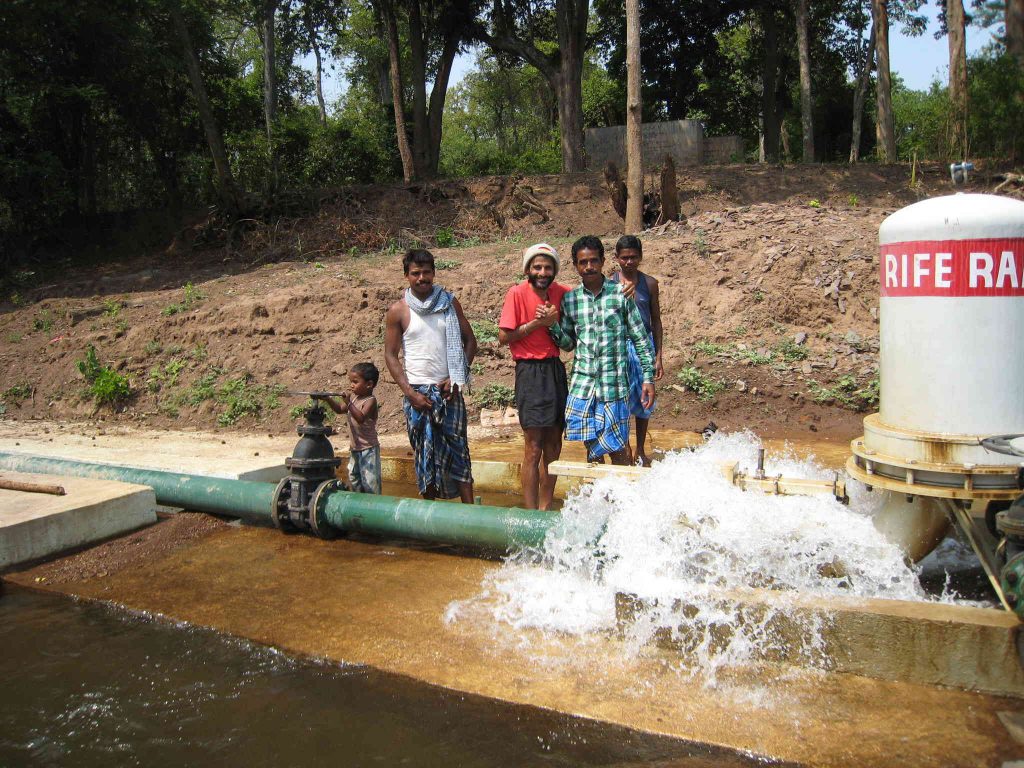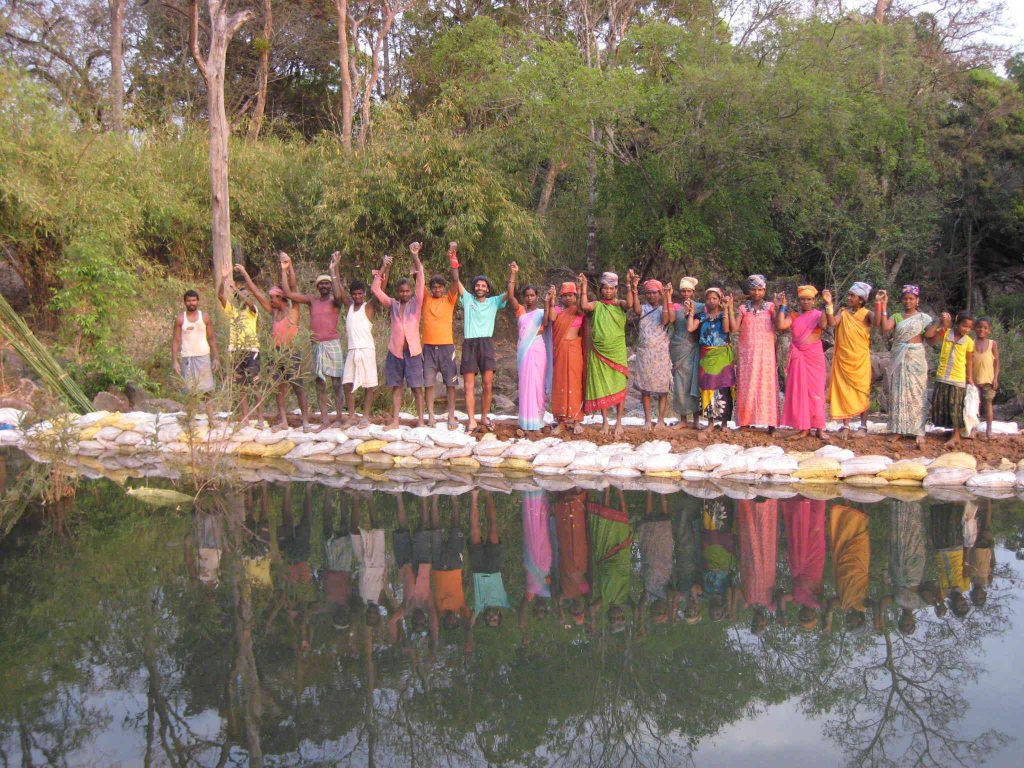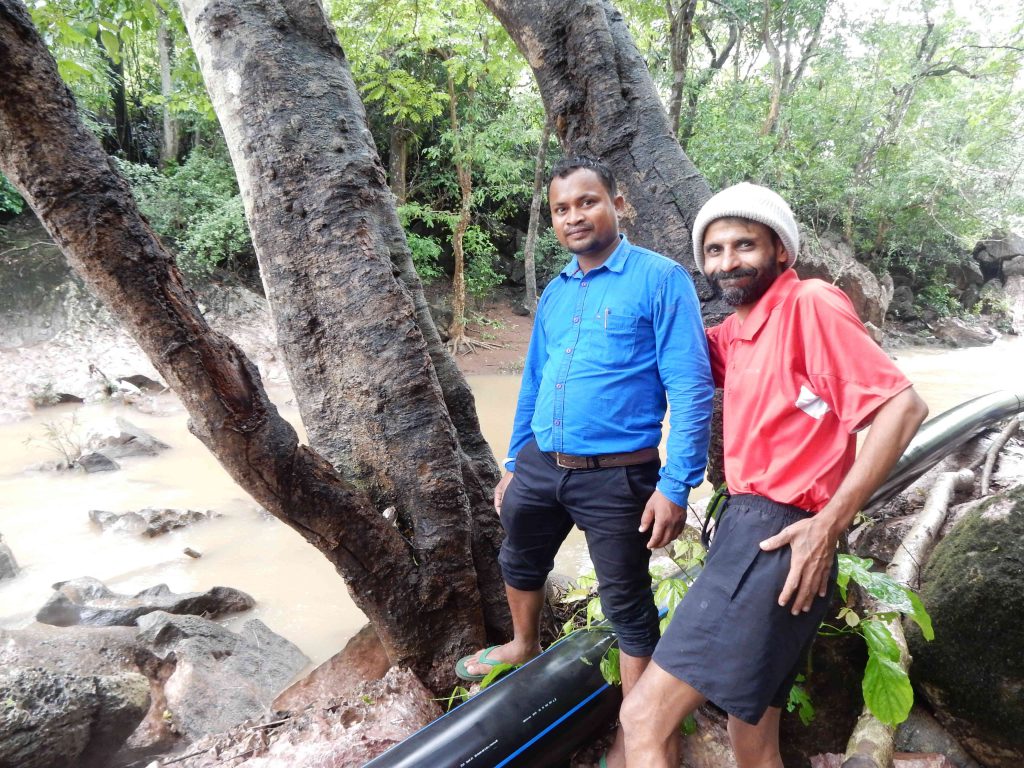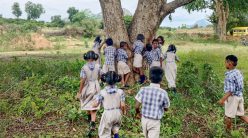An IISc scientist’s work on a local solution for water and power

Baliram Nag and I arrive on his bike at the Bastar District Collector’s residence, at the end of a leafy, secluded road in Jagdalpur. As we make our way past the security guards, they greet Bali warmly and ask him where the “vaigyanik” is. Punit Singh arrives a few minutes later, having jogged from the hotel.
We are meeting the Collector to discuss the project Singh is implementing in Bali’s village, Taipadar. Nearly ten years in the making, the project will deliver water for irrigation from Ganeshbahar Nala, a perennial stream close to the Adivasi village, using a ram-pump that works without electricity. The pump, in fact, worked successfully for about two months until heavy rain broke the makeshift dam the villagers had built. After a proper dam is built, a turbine, designed by Singh and gifted from Germany, will be installed.
Soon, Ayyaj Tamboli, the Collector, meets us and assures Singh and Bali of financial support, a sum of Rs 49 lakh already having been released for constructing a dam. He has also agreed to contribute Rs 75 lakh towards the pipelines for the turbine pump and a storage tank.
“This project will give us three benefits,” Bali tells me as I ride with him back to the hotel. “Water for irrigation and drinking, and also electricity.”
Earlier that morning, Bali and his friend Genu, who hails from a village upstream of Taipadar, had come with their bikes to take us to Taipadar, about 35 km away. The many small solar panels I spot in the fields en route were installed, Bali tells me, by the Chhattisgarh State Renewable Energy Development Agency (CREDA), which employs both him and Genu. They have installed solar panels in many villages in Bastar, including Taipadar, to pump water from borewells or to generate electricity sufficient for a few lamps in every home. As we approach Taipadar, villagers travelling in the opposite direction wave at Singh. This is his 14th visit to Taipadar in 2019, having made over 40 trips in ten years, doing the groundwork with Bali and others to make their dream a reality.
Heavy rain lashes Taipadar as we enter Bali’s home, which, like others in the village inside the Tiriya forest reserve, isn’t on the power grid. Bali, having lived in Jagdalpur for a few years with his wife and kids, now wants to move back to the village to be with his parents and brother, and see the project to completion. After the rain subsides, we make our way down to the stream and the makeshift dam that was breached in June.
Despite the perennial waters of Ganeshbahar (a tributary of the Sabari, which later joins the Godavari), the villagers have to rely on the monsoon for irrigating their crops, a situation not unique to Taipadar – less than 50 percent of the cultivable area in India is irrigated. Their Kharif crops – rice and pulses – are sown before the monsoon in June, and harvested by the end of the year. And though they do cultivate mustard in Rabi (sown in winter and harvested in spring), their productivity and income depends on the vagaries of the monsoon, forcing them to migrate to cities in search of jobs during the dry season. “They get very good rains during monsoons, more than India’s average,” says Singh, “But Taipadar is dry for eight to nine months.”

The makeshift dam was constructed by the villagers, funded by Singh himself. He is an assistant professor at the Centre for Sustainable Technologies, IISc. CST was founded in 1974 as the Centre for Application of Science and Technology for Rural Areas (ASTRA) by Amulya Reddy, who realised that more research in science and technology does not automatically alleviate poverty. If jobs are to be created by industrialising, research had to be linked to industrial needs – but industrial needs, and therefore research, would always reflect the interests of the elite in a “dual society” like India’s.
As an engineering student in Mysore, Singh struggled with this himself. He was introduced to Reddy’s work during his college days, influenced by his seniors and teachers. He also read a great deal about the Narmada Bachao Andolan, but could not completely comprehend the rationale behind people opposing development projects. Curious, he took up an internship with Samvada, an NGO that mentors youth from villages. He had his first confrontation with the ideology driving large-scale development projects when he travelled to Kaiga in 1996, then in the midst of a movement against the proposed nuclear power plant. There, he met an old woman who had no trouble recognising the power lines that would carry away energy to Bangalore while her own home remained in darkness. Singh searched for an explanation from the manager in charge of the plant, only to receive an angry assertion that the electricity was not meant for the villagers.
By then Singh had also read E.F. Schumacher’s book Small is Beautiful, which influenced the appropriate technology movement worldwide in the 1970s. The movement, responding to the prevailing views of development, advocated small-scale, decentralised, environmentally sustainable solutions. Later, during (and after) his PhD at the Karlsruhe Institute of Technology, Germany, he was involved in several projects where he helped build turbine pumps to generate electricity for local use in Tanzania, Java, and several places in India. When he returned to India in 2009, Singh, with some of his friends, went on “yatras” to villages in Gujarat, Uttar Pradesh, Uttarakhand, Chhattisgarh, Kerala and Nagaland, to understand first-hand the problems that people face – one of which was water for irrigation.
“I saw the potential for micro-irrigation in all these places,” Singh says. “But I asked myself – which place needs me the most? Where would nobody go? I chose this place [Taipadar] because the villagers told me that they need water and I felt competent that I can do something for them.” However, Ganeshbahar didn’t have a sufficient “head” (the elevation from which water flows) for a conventional turbine pump to work. So he worked on developing turbines for small streams for his Habilitation degree (a prerequisite before becoming a professor in many European countries).
And then he came across ram-pumps, which tap into the force of falling water to pump it uphill. The ram-pump, developed in the late 18th and early 19th century, uses nothing other than the kinetic energy of water to pump some of it, with a lower flow, to a higher point. Such a device has a chamber with, among other things, a “waste” valve and a delivery valve. When water in a ram-pump’s inlet pipe encounters the waste valve, initially in a lowered (open) position because of its own weight, it lifts the valve, closing it. This closure of the valve causes pressure inside the pump to build up – the water hammer effect – and exceed that due to the water pressing down from outside on the delivery valve, causing that valve to open and let out some of the water. Because it is being pumped to a higher point, the flow soon reverses, closing the delivery valve, and creating another water hammer that moves back up the inlet pipe, sucking the waste valve downwards into the open position again. And then the cycle repeats.
The ram-pump’s popularity waned after electricity arrived, though it is still manufactured on demand. For Taipadar, Singh bought a ram-pump from a US-based firm, which cost him about Rs 22 lakh, including the shipping charges. Since it was difficult to get funding, from institutions or from the government, for a project in its conceptual stage, he put in his personal money. He paid for the inlet and delivery pipes too.
The ram-pump, Singh says, is an ecologically gentle way of harnessing a river. “The technology that I bring in should make sure that the stream also exists,” he says. “Of the water that is taken from the stream, only five percent is used for irrigation. The remaining 95 percent goes back to the stream.” The small amount of water used for irrigation, Singh estimates, will increase the agricultural productivity of the village up to five times.

The larger project will also see a turbine installed to generate electricity for the village. Two turbines, designed by Singh, were manufactured by a 150-year-old German firm, KSB, and funded by their Foundation. The turbines arrived in 2015, but have been lying “abandoned in the Kavapal forest,” as a local news report put it – in their unopened boxes a short distance away on the bank overlooking the stream. “These turbines, when installed, can provide electricity to the village for ten months,” claims Singh. But all this needs money – Singh estimates that the full project would need Rs 6 crore, of which only about Rs 2.5 crore has been raised so far.
Initially, the government wasn’t supportive of the project. “They were discussing the project in terms of cost-benefits, that this would benefit only about 200 people and the cost was Rs 6 crore,” says Singh. So he worked with the villagers to construct a makeshift dam of sand bags to prove that the ram-pump worked. And Bali and a group of young boys decided to do collective farming, a plan that is now stalled: the ram-pump ran from May 2019 until heavy rains in late June destroyed the dam. Tamboli, who took over as Bastar district’s Collector recently, has now agreed to fund a proper dam, which will be built once the monsoon subsides.
I ask Tamboli if he thinks the project could be replicated elsewhere. “We can implement it wherever there are suitable conditions,” he says, referring to the “head” required for the ram-pump to operate. And why does the project interest him? “Even if we exclude the turbine and the plan of generating electricity, we are spending only Rs 5,000 per head per year for irrigating one crop,” he says. “If we have double cropping, that’s Rs 2,500 per head per year. So it’s economical from our point of view.” These figures, he explained, are for the 200 people-strong Taipadar, assuming the maintenance costs are a generous Rs 10 lakh per year. He contrasted this with a borewell that costs about Rs 13,000 and serves only one farm. “It uses up groundwater while this project relies entirely on surface water and serves an entire village,” he says. “That’s the advantage.”
But there are challenges other than financial too. We were on our way back to Jagdalpur when Bali and Genu take us to see the spot where Ganeshbahar joins the Sabari, from where the National Mineral Development Corporation (NMDC) will soon start drawing water for cleaning iron ore. A large concrete structure in the middle of the river is visible. The NMDC is building a processing plant on the Sabari that could imperil the Ganeshbahar’s perennial nature. “I am very worried about how this will affect the water balance of the local environment,” Singh says. He plans on doing a hydrological study with his PhD student, Siddhi, with help from river management experts from Germany.
The same NMDC employs Sukhram of Taipadar, whom we had just met before leaving the village. Sukhram stayed away from constructing the temporary dam, Singh says, possibly because he perceives the project as Bali’s rather than the village’s. This misconception may have arisen as it is Bali and his father – with other family and friends – who take the lead in implementing the project. It is Bali who has the training to maintain the system and it is through him that Singh has so far employed villagers for the construction work. What’s more, the highest point in the village where the piped water from the ram-pump arrives – as it did for two months – happens to be land belonging to Bali’s family. There, a tank will be built to distribute water to other farms through channels or pipes. One of those farms is being worked over by Sukhram as we approach; Singh waits for him with open arms and embraces him.

“Where have you been and why have you been staying away?” asks Singh. “Don’t break my heart.” Sukhram is initially evasive and, as Singh reminds him that the project belongs to the village, doesn’t quite meet Singh’s eye. “We have hired a tractor for you, use it to till your land too,” Singh tells Sukhram, holding his arm. Sukhram eventually appears to warm up and promises, with Bali standing nearby, that he will take part in the project and even leave NMDC when the work resumes.
Word about Singh’s work has spread, aided by local newspaper reports. The Collector of the neighbouring Sukma district saw a video of the ram-pump working in Taipadar, and invited Singh to see if something similar could be implemented in his district. So the next day, we travel to Sukma, passing by many Central Reserve Police Force (CRPF) camps on both sides of the excellent new roads. We notice that our vehicle doesn’t have a license plate. “The white towels [on the seats] will show it is an official vehicle,” Suraj, our young driver, assures us. We pass the spot where, in 2013, senior Chhattisgarh Congress leaders were killed in a Naxal attack, and then enter the Darbha valley, so thickly forested that mist surrounds us as we drive through.
In Sukma, we meet Jayant Kumar Lakra, Executive Engineer in the Water Resources Division. His career has taken him to all parts of Chhattisgarh, and he is clear why a long procession of development projects have failed in his state, as elsewhere in India. “Until and unless you involve the beneficiaries of your project,” he tells us over dinner, “ask them what they want, and make them the managers, all your projects will fail.”
Lakra’s father was a central government employee; he belongs to a tribe that, through education, has managed to escape the life of subsistence that is the harsh reality for many other tribes in a state cursed by its abundant mineral wealth. I ask Lakra if he knows many Adivasis, other than himself, who are part of the district administration. “Zero,” he says.
In Sukma, as in Jagdalpur, we saw businesses and shops run by people originally from outside Chhattisgarh, Adivasis being confined to working as hotel and restaurant staff. As Suraj later responded when we asked him if he had completed high school, “What’s the point of studying more if there are no jobs?” adding that those who do study further tend to be targets for acts of “black magic” by envious non-Adivasis.

The next morning, Lakra arrives with three others on a jeep at the government rest house where we had stayed overnight. We exit Sukma on a narrow concrete road that leads to Konta. The construction of the road, Lakra informs us, claimed the lives of more than a hundred CRPF men. After about 13 km, we turn off the road to Girdalpara, a village of about 300 Adivasis. “They are hard-working people,” says Lakra, seeing the many tractors parked by the side of the village’s main lane. We proceed to the river bank, where we stand on an existing concrete embankment. Singh, while talking to boys who were swimming and fishing, estimates that the river’s “head” is adequate to run a turbine – only during the non-monsoon months, when the village needs water the most.
Later, we meet with the men of the village. Lakra opens the conversation and then Singh takes over, explaining that the project, if implemented, would give them water for three crops a year compared to one now. He tells them about the Taipadar project, and how their fields wouldn’t lie fallow during the summer. They agree to his proposal.
As we leave, I ask the villagers if the district administration has tried to implement irrigation projects before. They tell me that successive plans for water have never been implemented. But Chandan Kumar, the Collector of Sukma district, is positive. “We want to see Bastar develop,” Kumar says. “There are a lot of streams here that we could put to use and such projects can help us achieve our goals.”
Singh, too, wishes to see more such projects. “I have a dream that more competent researchers from Indian academic institutions participate in the challenges of our hinterland, first in understanding and then solving them – especially challenges related to water,” he says. “There is an unparalleled joy in seeing satisfied beneficiaries that no awards or journal papers can give.”
With inputs from Rohini Krishnamurthy
To read more articles in our series on the monsoon, click on the following links:
Sulochana Gadgil: A Lifetime of Monsoon Research
MONTBLEX: India’s First Major Monsoon Experiment
Interview with Syed Ameenulla: ‘Ours was a small group, like one family’
BoBBLE: ‘An Unusually Successful Cruise’
Decoding the Signatures of Monsoons Past in Fossils and Genes
Why Knowledge Isn’t the Barrier to Water Conservation
Chanchal Uberoi on Monsoon Melodies




